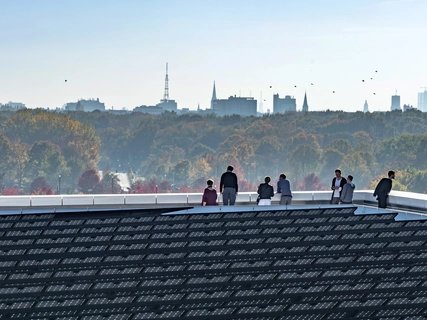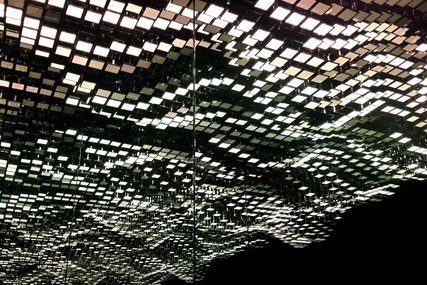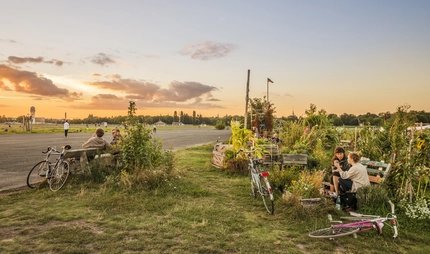
In no other city do past and future lie so close together as in Berlin. History can be felt everywhere in the city, and many forward-looking projects also make reference to it. Some venerable buildings and structures are being filled with new life, while other futuristic-looking projects and architectural masterpieces are being built on vacant lots and once desolate empty spaces in the city. We have selected the most beautiful ones for you. Discover the future city of Berlin. Here you can set the scene for the future in Berlin.
Tip 1: Skywalk with a view: Futurium

Berlin's Museum for Futures not only deals with the subject but is itself a showcase for forward-looking architecture and urban planning. As a low-energy building, the Futurium uses photovoltaics and solar thermal energy. A trip to the skywalk on the roof - like a visit to the museum - is free of charge. And in addition to the futuristic-looking backdrop of the sea of collectors, you'll also have a great view of the Spreebogen and the Chancellor's Office.
Where: Alexanderufer 2, Mitte
More about Futurium
Tip 2: Kaleidoscope mirror: The Cube

With the right angle, you can conjure up spectacular kaleidoscope images in front of the Cube's facade. 8,000 square meters of glass reflect the sun, clouds and surroundings. The square office building looks a bit like a futuristic mirror for the city. The "smart" building is certainly forward-looking - and not just because of its appearance. With 3800 sensors, the Cube is one of the "smartest" buildings in Berlin.
Where: Washingtonplatz 3, Mitte
Tips for a sustainable visit to Berlin
Tip 3: High Tech Worlds of Light: Dark Matter

The possibilities seem limitless: At Dark Matter, expansive light installations transform the dark halls of a former factory site into entirely new worlds. Light, sound, movement and bass vibrations merge into an immersive universe that invites you to experience your surroundings with all your senses. You'll explore seven rooms with different installations, each worthy of an Instagram post.
Where: Köpenicker Chaussee 46, Lichtenberg
Tip 4: Extraskeletal beam design: 50 Hertz

The 50Hertz is a real eye-catcher in the middle of the new Europacity quarter of the future, which is being built on the once desolate 40-hectare site north of Berlin's main train station. The standout element of the 50Hertz building is the white struts that run diagonally and horizontally along the façade, replacing the otherwise interior support structure. Solar and small wind turbines on the flat roof generate green power, but are only part of the energy-efficient interplay between the facade and building services that has earned 50Hertz several awards.
Where: Heidestrasse 2, Mitte
Tip 5: Iconic spiral: escalator in the KaDeWe department store

The new escalator design in KaDeWe is somewhat reminiscent of M.C. Escher's drawings. Here, the spiral-shaped constructions serve as orientation and each form the center of the department store's four zones, each of which is intended to appeal to a different customer group. Incidentally, the architectural firm Office for Metropolitan Architecture (OMA), founded by Rem Kohlhaas, is responsible for this most far-reaching redesign in the department store's more than one hundred-year history. The staircases, which are staggered in relation to each other and whose diameter increases towards the top like a tornado, take you to a different point on each floor. The walnut cladding is intended to recall the first modern escalators in New York's Macy's department store. These went into operation in 1902.
Where: Tauentzienstraße 21-24, Schöneberg
Tip 6: Gothic-inspired mushrooms: Rotes Rathaus subway station

In a glass elevator, you whiz down into one of Berlin's newest subway stations. Bright, open and modern, the Rotes Rathaus station has a minimalist color scheme of pure white and black terrazzo tiles, illuminated by LED downlights integrated into the concrete ceilings, which are also white. Glass partitions give a clear view of the action all around, reinforcing the feeling of being in a single, large hall. Mushroom-shaped white columns "grow" from the tracks up to the ceiling. A futuristic allusion to the Gothic vaulted forms that are meant to recall the time when the city hall was built.
Where: U5 stop Rotes Rathaus, Mitte
More about the new U5 museum line
Tip 7: Architectural icon of the 20th century: New National Gallery

Alongside the spectacular architecture of the Philharmonie Berlin, the Neue Nationalgalerie (New National Gallery), which reopens in 2021, is another eye-catcher on the grounds of the Kulturforum. The iconic building, which - opened in 1968 - is one of the highlights of Ludwig Mies van der Rohe's creative work, looks like a temple of glass and steel. At the same time, it gives a clear view of the other buildings on this western counterpart to Museum Island. At the right angle, you can make some interesting perspectives on St. Matthew's Church or the surrounding city panorama through the glass panes.
Tip: Learn more about the Utopia Kulturforum in our Podcast Berlin Unboxed. Have a listen!
Wo: Potsdamer Straße 50, Mitte
More about the Neue Nationalgalerie
Tip 8: Glass dome: Sony Center

Today you can see what the future looked like in the past by visiting the Sony Center. The complex was opened on the 26,000 square meter site in 2000. The 103-meter-high railroad tower is visible from afar. For great photos you can also go under the glass dome of the center. The fanned-out roof symbolizes Mount Fujisan, the residence of the kami, Japanese deities. With the "artificial" residence in Berlin's center, Sony wanted to ensure that it was also under the protection of the kami in Europe.
Where: Potsdamer Str. 4, Mitte
Tip 9: On the move: Monument of Freedom and Unity

At least you can already document the history of the future Freedom and Unity Monument. While the pedestal is already in front of the Humboldt Forum , the monument itself will probably not be inaugurated until the Day of German Unity in a few years. The gigantic, gilded bowl, the inside of which bears the inscription "We are the people. We are one people." can be walked on and, like a seesaw, tilts slightly to one side when a corresponding number of people move on it.
Where: Between the Humboldt Forum and the Spree River, Mitte
Berlin, capital of sculptures
Berlin, Capital of Sculptures
Tip 10: Looking Far and into the future: Former Tempelhof Airport

How can a former airport become a spot of the future? It's simple: A lot is happening in the buildings and gigantic hangars. Even the roof of the 1,000-meter-long building will be accessible in the future and present a history gallery. The former airport and the vast Tempelhof field are unique photo motifs in themselves. And with the Raisin Bar, thf cinema, exciting art exhibitions and events in the hangars, as well as the colorful sports and community program in Hangar 1 and the city's innovation lab CityLab, more and more doors are opening to the public.
Wo: Platz der Luftbrücke 4, Tempelhof
Tip 11: Connecting the City: Kronprinzenbrücke and Golda-Meir-Steg

You probably know the Kronprinzenbrücke (picture), which connects the Tiergarten district with the government quarter. But what about the Golda Meir Bridge, which has been crossing the Spandau Ship Canal like a golden ray of sunshine since December 2021? Named after Israel's first female prime minister Golda Meir (1898 - 1978), the walkway and bike path bridge is another connecting link in the once-divided city and also a symbol of the connection between Israel and Germany. From the promenade in eastern Moabit, you cycle over the 77-meter-long link directly to Europacity (behind the main train station) in the west. Under the bridge, a large flight of steps invites you to linger by the water.
Where: between Kieler Straße and Otto-Weidt-Platz, connecting Moabit and Mitte






